 This warm and changeable day turned out to be perfect for a visit to a National Trust garden. We drove quite smoothly through Romsey, and past the Mountbatten home of Broadlands, where we would normally expect to encounter queues of traffic. It was, however, as we neared our goal that we met the queues. Cars formed lines in each direction at the entrance to the overflow car park. The main one was already full at midday. Rather harassed young men with SECURITY stamped on their jerkins waved us in one by one. As we alighted we were told we were in the wrong place and likely to cause a bottleneck. It wasn’t immediately clear how we could do that, but Jackie, adopting the usual placid persona she reserves for anything to do with the car, calmly and collectedly moved her Modus to the far corner of the uncut meadow which served as a parking area.
This warm and changeable day turned out to be perfect for a visit to a National Trust garden. We drove quite smoothly through Romsey, and past the Mountbatten home of Broadlands, where we would normally expect to encounter queues of traffic. It was, however, as we neared our goal that we met the queues. Cars formed lines in each direction at the entrance to the overflow car park. The main one was already full at midday. Rather harassed young men with SECURITY stamped on their jerkins waved us in one by one. As we alighted we were told we were in the wrong place and likely to cause a bottleneck. It wasn’t immediately clear how we could do that, but Jackie, adopting the usual placid persona she reserves for anything to do with the car, calmly and collectedly moved her Modus to the far corner of the uncut meadow which served as a parking area.
What could possibly have brought all these vehicles to a National Trust house on a Tuesday in term-time? Ah. All was soon revealed. The aged of the nation had descended en masse on Mottisfont. We have now joined those privileged senior citizens who have done their time in their offices, factories, or whatever workplaces, and have the opportunity to litter the countryside with their presence. I posted a previous visit to Mottisfont on 7th September. This time, we were earlier in the season and able to enjoy the rose garden for which the house is justifiably famous.
This time, we were earlier in the season and able to enjoy the rose garden for which the house is justifiably famous.
For more than 800 years people have lived and worked on the Mottisfont estate. The name comes from a Saxon moot, or meeting place, by a fountain. This site remains in the grounds, and is still a clear spring.
Crossing one of the several threads of the River Test, one sees the house across rolling lawns.  Meadows are retained on the edges and the area is home to many a massive tree. Benches are dotted about and their shady situations offer places for rest or contemplation. Motorised buggies transport those less mobile.
Meadows are retained on the edges and the area is home to many a massive tree. Benches are dotted about and their shady situations offer places for rest or contemplation. Motorised buggies transport those less mobile.
We immediately made our way to the walled garden that contains many roses itself, and leads into the showpiece.
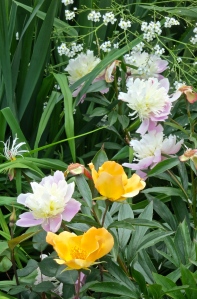 Last September there were still some roses in bloom, so I was familiar with the garden created by the Gardens Adviser to the National Trust, but I was totally unprepared for the magnificent display that greeted us as we made our way through the ancient brick walls to the gravel and stone paths laid amongst the profusion and variety of colourful flora.
Last September there were still some roses in bloom, so I was familiar with the garden created by the Gardens Adviser to the National Trust, but I was totally unprepared for the magnificent display that greeted us as we made our way through the ancient brick walls to the gravel and stone paths laid amongst the profusion and variety of colourful flora.  That the sun had chosen to light up the garden, filled with pensioners, some of whose clothing matched the horticultural hues, completed the picture.
That the sun had chosen to light up the garden, filled with pensioners, some of whose clothing matched the horticultural hues, completed the picture.
I think Monet would have loved it. 
Whether one focussed on the whole landscape picture with the figures of those of a certain age dotted about amongst the flowers, or on the blooms themselves, there was much to delight the eye.

 Among the roses can been seen other plants such as peonies, irises, delphiniums, or allium. All clearly benefitting from well-nurtured soil.
Among the roses can been seen other plants such as peonies, irises, delphiniums, or allium. All clearly benefitting from well-nurtured soil.
The aforementioned Gardens Adviser was Graham Stuart Thomas. He moved his outstanding collection of old-fashioned shrub roses to Mottisfont’s walled garden during 1972 and 1973.
A fine yellow rose bears his name.
We chose not to visit the house today, and went for a walk along the river bank. Last September there was an exhibition in the house of E.H.Shepard’s illustrations to Kenneth Grahame’s ‘The Wind in the Willows’. Shepard’s drawings include an iron bridge much like the one you must cross to reach the riverside walk. Indeed, to accompany the exhibition, a rowing boat such as Toad may have used, had been moored by the bridge.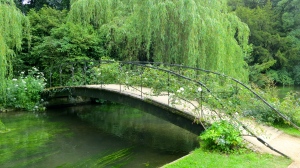
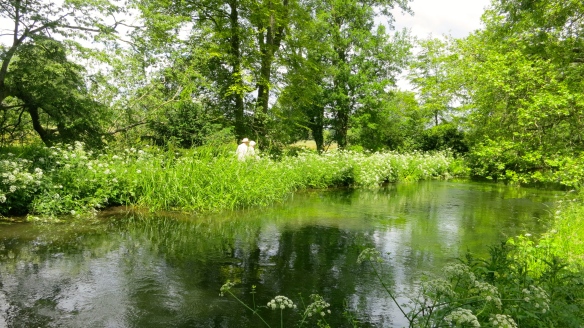 A number of couples walked along the water’s edge. Some ventured even further, into a vast meadow where cows lowed.
A number of couples walked along the water’s edge. Some ventured even further, into a vast meadow where cows lowed.
Ready for a sudden insecticidal leap to the surface, large trout lurked like U-boats among the underwater reeds that were flattened and fanned out by the swift flowing current that forced the ducks to paddle furiously just to persist in their desire to swim against it.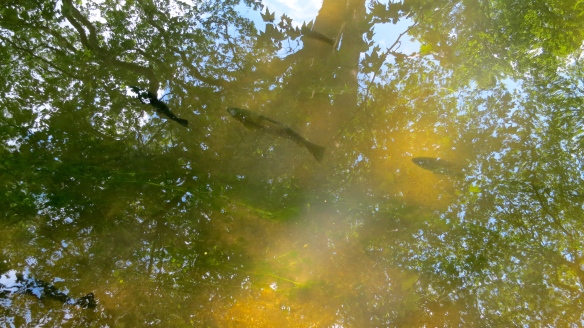
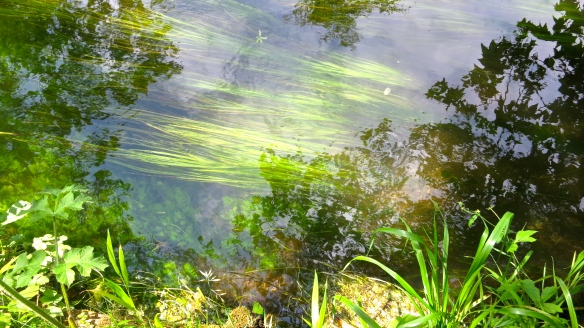
As we made our way past an enormous sylvan structure that is two ancient plane trees in one, a troop of children that must have had very little impact on the average age of today’s visitors, fell over each other to be the first to reach the subject of their field trip. 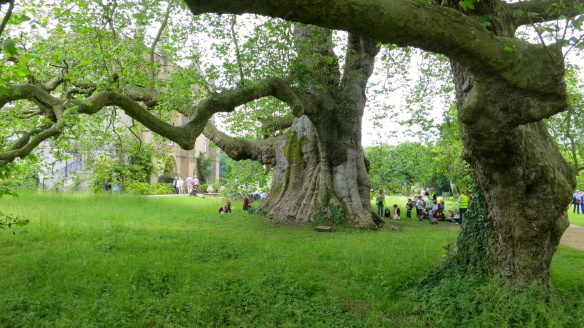 Their escorts struggled to keep them to order.
Their escorts struggled to keep them to order.
Back home we learned that all the garages had been broken into overnight. We lost nothing. One man lost a torch, and another, two golf clubs. It was rather difficult to see the point of the burglary.
Jackie made a juicy liver casserole as an excuse to use the giant cauliflower she had bought a couple of days ago. This was enjoyed on my part with the last of bottle number 012919 of the Terres de Galets and the first of number 000198.
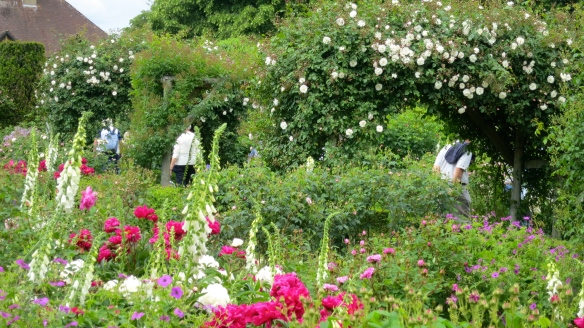
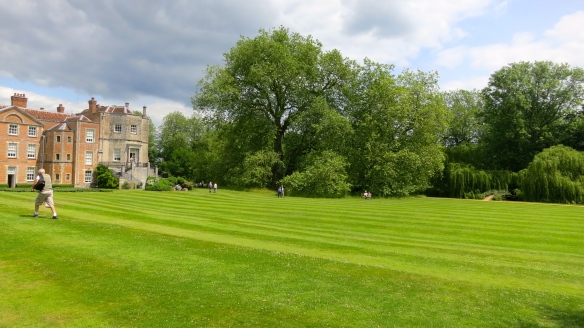
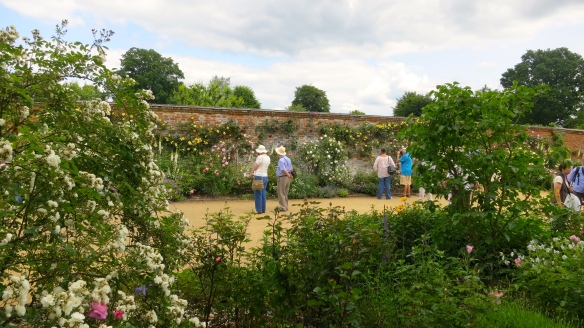
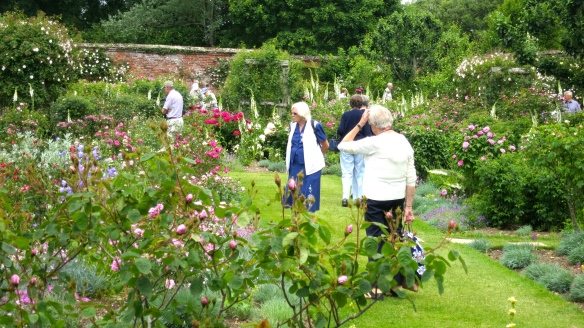
Woah this site is definitely wonderful everyone loves reading your posts. Continue to be inside the great work! You are already aware, many people tend to be looking game due to this information and facts, you may aid these people enormously.
I hear that they spare no expense on their garden. I will definitely have to visit.
Thank you, Sol
Hello, your article popped up in Google. I am currently reading ‘Three Gardens’. In the last part where GST features Briar Cottage and refers to “under reduced circumstsnces” and wonder are you able to shed light. GST certainly was loathe to leave his previous property Oak Cottage. At first I assumed “under reduced circumstances” referred to the much smaller garden at Briar Cottage but then thought by an odd comment he made it may actually mean reduced financial circumstances. If so, I would find that amazing and sad if a man such as GST found himself in “reduced circumstances” in the latter part of his life. I enjoyed your article. Thank you, Irene
And thank you very much, Irene.
Very elegant. Reminded of the time I went to the Chelsea Flower show a few years back. The flowers and the plants were endless as were the vegetables. Each display, was eye candy for me.
Thank you so much, Zakiah
I love the Wind in the Willows reference! (A childhood favorite for both my mother and me.)
Thank you very much, Liz
You’re welcome, Derrick.